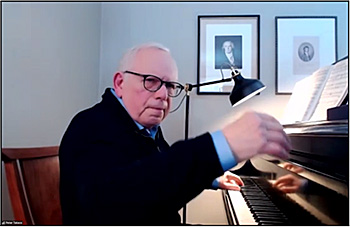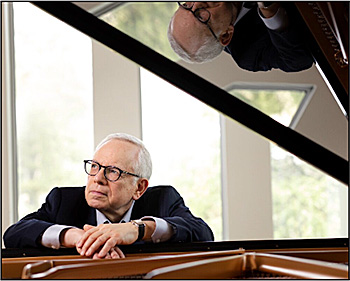Music Educators Association of New Jersey
Serving teachers and students since 1927


“Alapwobl” Leon Fleischer taught. What? What language is that? Peter Takács, student of the famous pianist and pedagogue, learned well. Now professor of piano at Oberlin Conservatory, Peter Takács has recorded all 32 Beethoven sonatas. Rhythm is obviously not the only element in music, he said, but one of the most important. Using the sonatas as a backdrop, he discussed tempo, pulse, rhythm and phrasing — plus the all-important alapwobl effect.
TEMPO
Beethoven was most concerned with tempo. He became frustrated because musicians could not find the correct tempo when performing his works. It is important to note that the same tempo may be indicated in different pieces, but may create entirely different effects. Also, the interpretation of tempo markings differed in different eras; for example, andante, the walking pace, was faster in Haydn and Mozart’s time than in the 19th century.
In his later sonatas Beethoven used German tempo markings as well as the Italian to make his directions more precise. In Sonata No. 28 (Op. 101, I) Allegretto, ma non troppo became Etwas lebhaft, und mit der innigsten Empfindung: Somewhat fast and with innermost feeling. In the fourth movement where the Italian simply indicates Allegro, Beethoven elaborates with Geschwinde, doch nicht zu sehr, und mit Entschlossenheit: Quickly, but not too much, and with determination. Now we have purpose!
 The Maelzel metronome, crafted circa 1815, introduced more accuracy in tempi, and Beethoven swiftly adopted its use. He is said to be the first composer to indicate metronome markings in his compositions. But those markings have evolved over time. In the 1821 Hammerklavier (Op. 106) the metronome marking for a half note = 138. Today we think that is too fast. The metronome App for the iPhone is a very helpful digital practice tool. Using the tap feature, you can customize the clicks. Establish the tempo first, Mr. Takács advised, then practice without the mechanical crutch.
The Maelzel metronome, crafted circa 1815, introduced more accuracy in tempi, and Beethoven swiftly adopted its use. He is said to be the first composer to indicate metronome markings in his compositions. But those markings have evolved over time. In the 1821 Hammerklavier (Op. 106) the metronome marking for a half note = 138. Today we think that is too fast. The metronome App for the iPhone is a very helpful digital practice tool. Using the tap feature, you can customize the clicks. Establish the tempo first, Mr. Takács advised, then practice without the mechanical crutch.
The genre or type of piece will often determine tempo. Are you playing a minuet, a march, a toccata? The seductive theme in Sonata No. 30 (Op. 109, III) is a sarabande that one should be able to dance to. Beethoven again sets the tone here with Gesangvoll, mit innigster Empfindung: In a singing voice, with innermost feeling. Sonata No. 22 (Op. 54), a two movement sonata, (in Tempo d’un Menuetto and Allegretto, Più Allegro), begins with a minuet followed by a toccata finale that really moves. In contrast, the Pathétique (Op. 13, I) uses the French Overture style to create a very solemn effect indicated appropriately as Grave. Each genre suggests its characteristic tempo.
Tempo consistency is crucial to keeping a piece’s overall structure intact. However, we may be flexible within the chosen tempo. In Sonata No. 3 (Op. 2, No. 3), which begins con brio, the Adagio second movement is simply too slow in Mr. Takács’s opinion. There is so much motion in the music that we must use our inner sense regarding the tempo. Rubato has its place in Beethoven’s music, but should not be overdone. Using rubato in the sarabande mentioned above, for example, would be appropriate.
PULSE
In crime shows, if a body has no pulse it’s dead. The same with music — pulse is essential. Do we have 2/4, 3/4, 9/8 as a time signature? The Waldstein (Op. 53), with its driving bass, is in 4/4. The Tempest (No. 17, Op. 31, No.2) cuts the pulse in half with alla breve. The Appassionata (No. 23, Op. 57) excites because of its 12/8 meter.
 Whether it is a slow movement or a fast one, you must consider the meter to feel the correct pulse. Subdivide in the slow themes: in the Pathétique (I), which is in 4/4, you might count 8. Les Adieux (No. 26, Op. 81a, I) scored for 2/4, feels more like 4/4. Something is always happening inside these measures; let it happen. For the fast movements, “think in ones.” In Sonata No. 6, (Op.10, No. 2, III), each presto measure in 2/4 can be felt in one beat. Likewise, regard the furiously fast Prestissimo 2nd movement (in 6/8) of Op. 109.
Whether it is a slow movement or a fast one, you must consider the meter to feel the correct pulse. Subdivide in the slow themes: in the Pathétique (I), which is in 4/4, you might count 8. Les Adieux (No. 26, Op. 81a, I) scored for 2/4, feels more like 4/4. Something is always happening inside these measures; let it happen. For the fast movements, “think in ones.” In Sonata No. 6, (Op.10, No. 2, III), each presto measure in 2/4 can be felt in one beat. Likewise, regard the furiously fast Prestissimo 2nd movement (in 6/8) of Op. 109.
Another way to feel the pulse of a piece is to practice being a conductor. Conducting the Maestoso introduction to Op. 111, for example, is a great way to hear the music come together. Conducting encompasses your entire body and evokes an amazing feeling related to the music. No orchestra? Try conducting to the recording.
RHYTHM
No piece can be played convincingly unless you understand the rhythm and feel the short and long notes. Mr. Takács recommends starting out as a drummer — clapping or tapping the rhythm. The Appassionata’s Allegro assai, in 12/8, is a challenge rhythmically, so clap it before you tackle it. What happens between the notes — the silence — is equally important. Artur Schnabel, one of the first pianists to perform all Beethoven’s sonatas and a teacher in his own right, emphasized the silences. Respect them, he taught; don’t even move during the silence. In Sonata No. 4 (Op. 7) the second movement, Largo, con gran espressione, is slow with much space and many rests between the notes. They create a lonely and desolate theme. Listen to the silence.
Various note values produce amazing effects. The even notes of the Pastorale (Op. 28, I) suggest constancy, whereas the even notes of the Waldstein create excitement. Fast notes want to move and give direction, while slow notes prefer to sit (Op. 49, No. 1, I). The dotted rhythms, like those in Sonata No. 5 (Op. 10, No. 1, I), contain their own energy and played at tempo Allegro molto e con brio are breathtaking. In the second theme of the same movement, the syncopation offers a more soothing vibe. Mr. Takács says to feel the tied note “somewhere in your gut.” Delay the resolution. Also in Op. 31, No. 1, I, massage the tied note. Beethoven wants you to feel the note, not play it.
Which leads us, finally, to alapwabl or a.l.a.p.w/o.b.l. — the Leon Fleischer effect:
“Good rhythm means to play as late as possible without being late.”
When you have rests, syncopation and tied notes, Professor Takács always prescribes to wait as long as you can to get to the next note; be on the edge of correctness. It can lead to suspense and an energetic performance. An excellent example is the opening theme of the Rondo in Op. 10, No. 3. The rests are everything to this rhythm. Breathe. Stop. Let the rests do their thing.
PHRASING
The Appassionata’s second movement, Andante con moto, introduces a beautiful theme with lovely harmony written in two traditional eight-bar phrases. However, to capture its real beauty, one should look at it in two-bar phrases — and sing the melody. It is beautifully constructed and charged with expression. There are numerous dotted notes and rests; try not to distort the rhythm. Imagine tired soldiers coming home from the war. Singing the melody helps to capture the mood.
In shaping the phrases, like those of the Moderato cantabile molto espressivo main theme in Op. 110, you must make decisions on how loud or soft to make each one. Here again you can start with two-bar phrases, but begin con amabilità — tenderly — so you can gradually increase the intensity.
Dovetailing in music is similar to that in carpentry, where you must fit two interlocking pieces together to form a harmonious whole. When looking at musical phrasing, ask “How do I finish one phrase and start another?” The end of one must mesh with the beginning of the next. This requires experimentation and there is a big difference between being musical or lyrical and mechanical. The Minuetto in Op. 31, No. 3 highlights a graceful melody that starts with an upbeat. While the slurs don’t go over the bar line, the melody certainly does. Singing the melody will be helpful when phrasing this properly. In the Pathétique’s second movement, Adagio cantabile, we encounter this as well. Pay attention to the slurs; some of them do go over the bar. Some of the slurs are a little unusual, but they work.
We graciously thank Peter Takács for a most informative and practical presentation. His command of the sonatas is profound, especially when he played so many examples without a score. And despite the Zoom platform, his tone and touch on the piano were conveyed simply beautifully. Bravo!
[For more biographical information and info about the re-release of his CD set of Beethoven sonatas, please visit www.petertakacspianist.com.]
Charlene Step,
Writer and Layout Designer
Anna Berschadsky,
Meeting Hostess
Photos by Lisa Gonzalez
 In 2011 when the Beethoven CD collection was initially released, Peter Takács said:
In 2011 when the Beethoven CD collection was initially released, Peter Takács said:
“I have lived with these magnificent works, as performer and teacher, for many years. I find in them a record of a great composer's development from his youth as a brilliant virtuoso to the peaks of musical maturity. One recurrent aspect of these sonatas is their strikingly modern relevance as universal statements about the human condition—about struggle and suffering, healing and transcendence. In them one gleans a mind intent on surprising and delighting the listener, pushing the envelope of accepted rules, and being inspired by nature both in its pastoral serenity and its turbulence.”